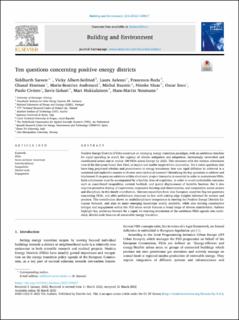Ten questions concerning positive energy districts
Sareen, Siddharth; Albert-Seifried, Vicky; Aelenei, Laura; Reda, Francesco; Etminan, Ghazal; Andreucci, Maria-Beatrice; Kuzmic, Michal; Maas, Nienke; Seco, Oscar; Civiero, Paolo; Krangsås, Savis Gohari; Hukkalainen, Mari; Neumann, Hans-Martin
Peer reviewed, Journal article
Published version
Permanent lenke
https://hdl.handle.net/11250/3013274Utgivelsesdato
2022-04-01Metadata
Vis full innførselSamlinger
Originalversjon
Building and Environment. 2022, 216 .Sammendrag
Positive Energy Districts (PEDs) constitute an emerging energy transition paradigm, with an ambitious timeline for rapid upscaling to match the urgency of climate mitigation and adaptation. Increasingly networked and coordinated actors aim to realise 100 PEDs across Europe by 2025. This resonates with the mission orientation turn of the European Green New Deal, to inspire and enable target-driven innovation. Yet it raises questions that have long perplexed scholars and practitioners in energy transitions: how can rapid diffusion be achieved in a sustained and replicable manner in diverse socio-technical contexts? Identifying the key questions to address and implement fit-to-purpose solutions within short-term project timescales is essential in order to mainstream PEDs. Such solutionism must be accompanied by a healthy dose of scepticism, in order to avoid undesirable outcomes such as exacerbated inequalities, societal backlash, and spatial displacement of invisible burdens. But it also requires proactive sharing of experiences, responsive learning and dissemination, and cooperation across sectors and disciplines. In this timely contribution, thirteen researchers from nine European countries flag ten questions concerning PEDs, and offer preliminary responses in line with cutting-edge insights informed by science and practice. This contribution draws on multidisciplinary competence in steering the Positive Energy Districts European Network, and aims to make emerging knowledge widely available, while also inviting constructive critique and engagement within the PED arena which features a broad range of diverse stakeholders. Authors highlight key pathways forward for a rapid, far-reaching translation of the ambitious PEDs agenda into multi-sited, district-scale beacons of sustainable energy transition.

